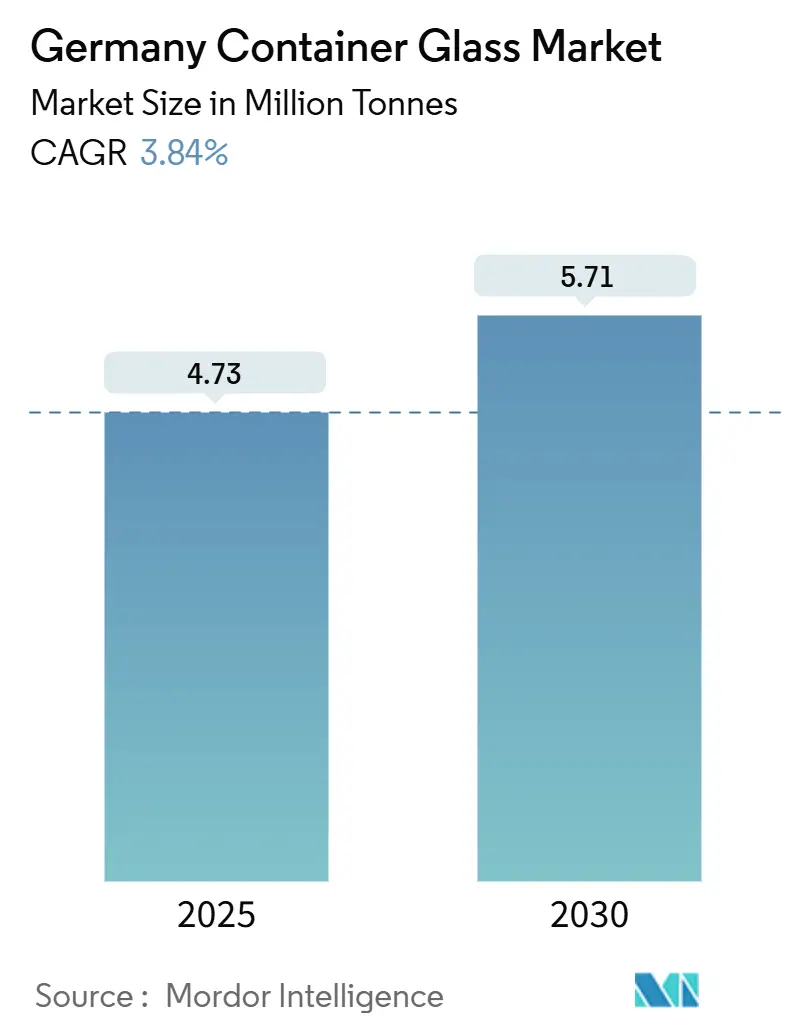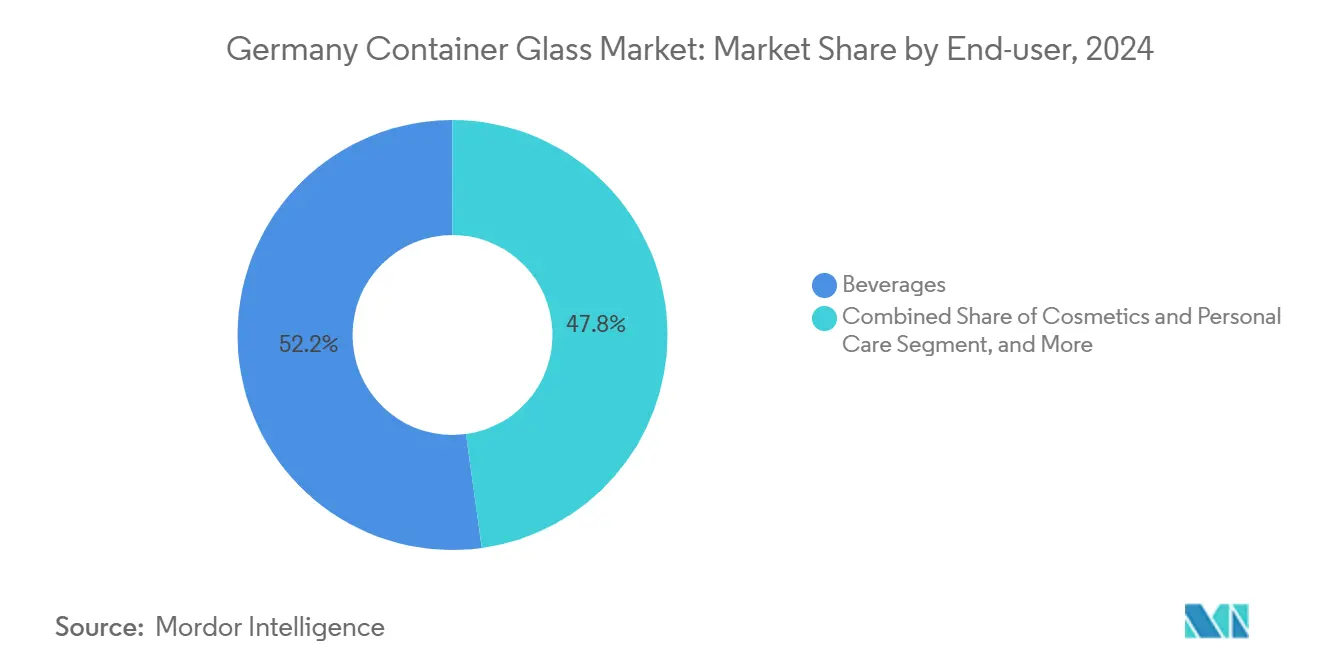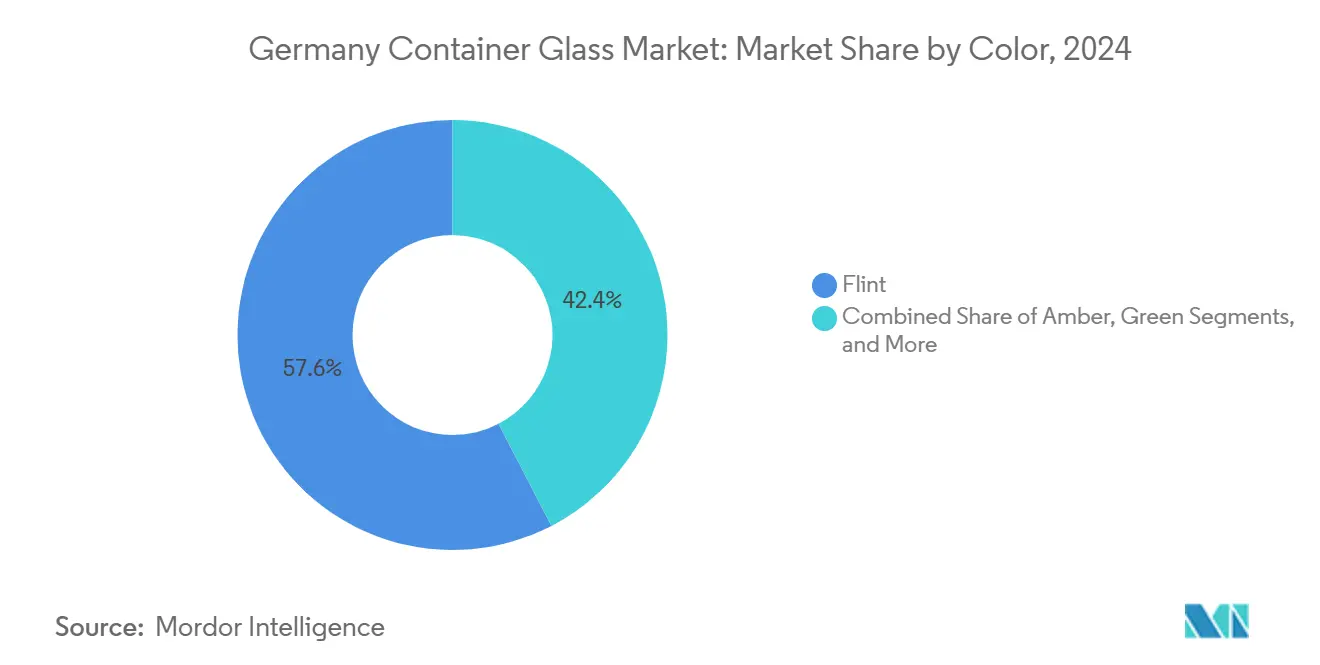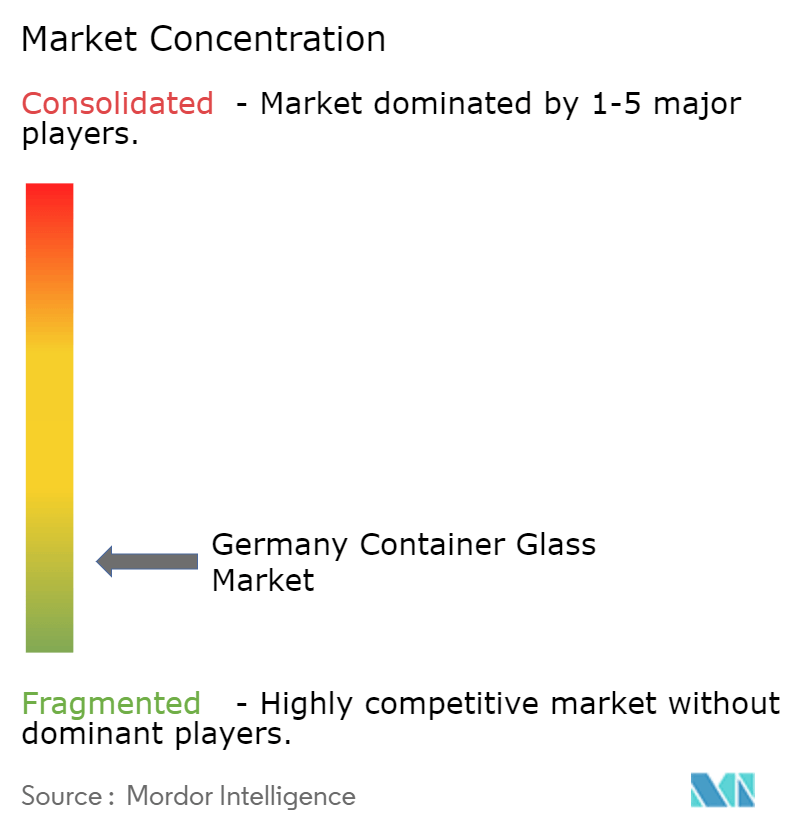
Germany Container Glass Market Analysis by Mordor Intelligence
The Germany Container Glass Market size is estimated at 4.73 million tonnes in 2025, and is expected to reach 5.71 million tonnes by 2030, at a CAGR of 3.84% during the forecast period (2025-2030). The market's medium-term momentum is underpinned by lightweight glass innovation, hybrid furnace deployment, and the government's circular economy strategy, despite the impact of energy prices and a multi-year decline in beer volumes on near-term growth.[1]Lebensmittel Praxis editorial team, "Glas in der Krise – Wie hohe Energiepreise und sinkende Nachfrage die Glashersteller bedrohen," Lebensmittel Praxis, lebensmittelpraxis.de Premium beverage owners are specifying customized bottles that reinforce brand identity while reducing their carbon footprint, and pharmaceutical fillers are shifting toward sterile, ready-to-use containers that meet EU Good Manufacturing Practice Annex 1 guidelines. National targets for 25% recycled raw material use and 80% glass collection rates position container glass favorably against plastic, whose producers now face minimum recycled-content thresholds. Scale manufacturers are responding with capacity rationalization and investments in low-carbon technology, a dual strategy that is expected to boost productivity and reduce per-ton emissions. Germany container glass market participants able to secure renewable power and deploy hybrid melting technology are forecast to capture the bulk of incremental demand from high-value pharmaceutical, cosmetics, and premium spirits applications.
Key Report Takeaways
- By end-user, beverages captured 52.17% of the Germany container glass market share in 2024.
- By color, the Germany container glass market size for the amber segment is projected to grow at a 4.51% CAGR between 2025-2030.
Germany Container Glass Market Trends and Insights
Drivers Impact Analysis
| Driver | (~) % Impact on CAGR Forecast | Geographic Relevance | Impact Timeline |
|---|---|---|---|
| Increasing Demand for Recyclable Packaging in Germany | +1.2% | National, with strong urban adoption | Medium term (2-4 years) |
| Growing Pharma Sector Boosts High-Quality Glass Packaging | +0.8% | National, concentrated in pharma hubs | Long term (≥ 4 years) |
| Premium Beverages Drive Customized Bottle Requirements | +0.6% | National, premium retail channels | Short term (≤ 2 years) |
| Circular Economy Policies Strengthen Glass Recycling Systems | +0.9% | National, EU-wide regulatory alignment | Medium term (2-4 years) |
| Sustainability Targets Accelerate Lightweight Glass Innovation | +0.7% | National, export-oriented producers | Medium term (2-4 years) |
| Industry Consolidation Reshapes Container Glass Capacity | +0.4% | National, regional production clusters | Short term (≤ 2 years) |
| Source: Mordor Intelligence | |||
Increasing Demand for Recyclable Packaging in Germany
The National Circular Economy Strategy, adopted in January 2025, mandates that 25% of strategic raw material demand be met through recycling and that per capita municipal waste decline by 10-20% by 2030-2040. This framework elevates container glass, whose infinite recyclability and stable quality outperform polymer substitutes. Roughly 300,000 public glass-collection points already deliver glass return rates above 80%, providing producers with a dependable cullet stream and reducing furnace energy demand by up to 30% per ton of glass melted.[2]Grüner Punkt, “Glasrecycling | Grüner Punkt,” gruener-punkt.de Digital product passports planned under the strategy will document the recycled content, creating competitive differentiation for bottles containing high levels of cullet. Brands seeking to comply with forthcoming single-use plastic recycled-content mandates find glass to be a straightforward path to achieving packaging sustainability targets, thereby bolstering demand for Germany's container glass market.
Growing Pharmaceutical Sector Accelerates High-Quality Glass Demand
SCHOTT Pharma recorded EUR 957 million (USD 1.08 billion) in revenue for 2024, representing a 12% constant-currency increase. High-value syringes and ready-to-use (RTU) containers now account for 55% of turnover.[3]SCHOTT Pharma press office, “SCHOTT Pharma with strong growth and record margin after solid year-end finish,” SCHOTT Pharma, schott-pharma.com Germany’s concentration of biologics production and the introduction of new GLP-1 therapies are driving demand for low-alkali, low-particle glass formats that can withstand lyophilization and maintain drug stability. The “Alliance for RTU” formed by SCHOTT Pharma, Gerresheimer, and Stevanato Group is standardizing RTU specifications to streamline pharma filling lines and reduce contamination risk, further expanding the addressable market for premium borosilicate and aluminosilicate glass. These trends channel incremental volume to producers that can certify USP <660> and EU Pharmacopoeia Type I compliance while offering rapid changeover and sterile supply capabilities.
Premium Beverages Drive Customized Bottle Requirements
Volume contraction in mainstream beer is shifting production toward value-added spirit, craft, and alcohol-free SKUs, all of which favor unique bottle shapes, embossing, and colored glass finishes. Vidrala’s 260-gram 75 cl bottle and Diageo’s 180-gram Blue Label Ultra demonstrate how lightweighting can coexist with luxury cues, saving over 0.5 g of CO₂ for every gram of glass removed. Brand owners demand quick design iterations and small batch runs, encouraging manufacturers to install digital decoration lines and flexible forming machines. Customized premium formats help preserve price elasticity, protecting margins in a cost-inflated environment and sustaining Germany's container glass market expansion in the near term.
Circular Economy Policies Strengthen Glass Recycling Systems
EU Packaging and Packaging Waste Regulation revisions harmonize deposit-return schemes, labeling, and recyclability performance thresholds across member states, accelerating investments in reverse logistics and color-sorting infrastructure. Germany already meets the 90% separate-collection target for glass, enabling cullet ratios that exceed 70% in emerald and amber furnaces. Higher cullet lowers melting energy by up to 25% and cuts furnace emissions, supporting compliance with EU Emissions Trading Scheme Phase IV benchmarks. Producers that can demonstrate lower life-cycle inventory scores are favored by multinational beverage and pharma customers pursuing Scope 3 carbon cuts, strengthening the revenue outlook for compliant suppliers.
Restraints Impact Analysis
| Restraint | (~) % Impact on CAGR Forecast | Geographic Relevance | Impact Timeline |
|---|---|---|---|
| Rising Energy Costs Elevate Glass Production Expenses | -1.8% | National, energy-intensive regions | Short term (≤ 2 years) |
| Competition from PET and Imported Glass Packaging | -1.2% | National, mass retail channels | Medium term (2-4 years) |
| Regulatory Compliance Raises Barriers for Small Producers | -0.6% | National, affecting SME producers | Medium term (2-4 years) |
| Plant Closures Reduce Local Supply Availability | -0.8% | Regional, industrial clusters | Short term (≤ 2 years) |
| Source: Mordor Intelligence | |||
Rising Energy Costs Elevate Glass Production Expenses
Industrial electricity hovered near EUR 40 (USD 43.2) per MWh in 2024-2025, roughly four times pre-crisis levels, while natural-gas price spikes raised total melt costs despite temporary government subsidies. Because melting at 1,600 °C accounts for 70-75% of furnace operating cost, elevated power prices erode profitability and compress investment budgets. Hybrid furnaces can reduce CO₂ by up to 64%, as demonstrated by Ardagh’s NextGen line, yet still rely on competitively priced renewable electricity. Until grid decarbonization and industrial power-price relief stabilize input costs, Germany's container glass market capacity growth will lag potential demand.
Competition from PET and Imported Glass Packaging
PET’s lightweight profile trims transport emissions and freight bills, giving it a raw-material advantage when resin prices are low. O-I Glass reported price gaps above 30% between PET and glass in late 2024, triggering SKU shifts to cans and plastics in cost-sensitive segments. Imported bottles from lower-cost regions further pressure domestic manufacturers when exchange-rate movements narrow delivered-cost differentials. Glass regains market share when the price gap falls below 15%, highlighting the importance of lightweighting and cullet usage in reducing the delivered-cost base and preserving Germany's competitiveness in the container glass market.
Segment Analysis
By End-User: Beverage Leadership Under Pressure, Pharma Surge Continues
Beverages retained 52.17% of the German container glass market share in 2024, equivalent to 2.47 thousand kilotons, reflecting the entrenched traditions of refillable beer and wine. However, from January to May 2025, beer shipments fell 6.8% to 34.1 million hectoliters, marking the lowest post-reunification level, which trimmed bottle demand and prompted brewery rationalization. Germany's container glass market size linked to standard beer bottles is projected to contract at a low single-digit CAGR through 2030. Spirits, craft, and alcohol-free malt drinks partly offset this decline by adopting bespoke lightweight glass that commands premium shelf prices. Producers serving these niches can defend margins by offering rapid mold turnaround and low-CO₂ glass certificates.
Pharmaceutical applications accounted for an estimated 10% of Germany's container glass market size in 2024, yet are forecast to outpace beverages, expanding at a 6% or more CAGR, thanks to the growing demand for biologics, GLP-1 injectables, and mRNA vaccines. Stringent EU Annex 1 rules promote RTU vials and syringes that deliver sterility assurance and line efficiency, thereby lifting average selling prices and reducing the grades of cullet required. Cosmetics and personal care hold only 8% volume but post the fastest 5.17% CAGR as premium skin-care brands switch from plastic to glass for a luxury unboxing experience. Food jars maintain a resilient mid-single-digit share, benefiting from consumer perception of glass as inert and reusable, although growth mirrors that of the broader grocery market.

Note: Segment shares of all individual segments available upon report purchase
By Color: Flint Dominance Meets Amber Acceleration
Flint retained 57.61% of the German container glass market share in 2024, buoyed by its transparent positioning for spirits, RTD coffee, and pharma liquids. Yet higher cullet rates and oxygen-rich firing now allow flint lightweighting without haze, creating price room for brand owners. Germany's container glass market size for flint bottles is projected to grow at a 2.5% CAGR, as premium categories offset the weakness in beer sales. Amber glass logged a 22% share and is forecast to post a 4.51% CAGR to 2030, propelled by UV-sensitive biologics and craft beers seeking a heritage look. Pharmaceutical demand for amber vials that block 300-450 nm wavelengths strengthens furnace utilization, and SCHOTT Pharma’s expansion in Hungary adds capacity that feeds German fill-finish lines.
Green retains niche demand in wine and specialty beer but faces volume pressure from changing consumption patterns. Colored flint derivatives such as emerald and sapphire capitalize on brand storytelling and carbon-reduced credentials, with Ardagh’s low-carbon emerald bottle for Jägermeister signaling the design flexibility of hybrid furnacing. While together these specialty colors occupy under 5% of Germany container glass market size, they grow above average and attract premium pricing, improving color-mix profitability.

Note: Segment shares of all individual segments available upon report purchase
Geography Analysis
Germany container glass production clusters around North Rhine-Westphalia, Bavaria and Lower Saxony, regions that provide legacy furnace infrastructure, glassmaker skilled labor and proximity to beverage and pharma customers. North Rhine-Westphalia hosts leading spirit glass plants aligned with the Düsseldorf-Cologne logistics corridor, facilitating export flows into Benelux and France. Bavaria’s presence of craft breweries supports bespoke bottle orders, yet declining local beer volumes have reduced furnace pull, prompting producers to court cosmetics fillers in Nuremberg and Munich. The Eastern states, particularly Saxony-Anhalt and Thuringia, display growth potential since land and electricity costs remain below national averages; hybrid furnace projects under permitting here target first melt in 2027-2028, which will raise regional Germany container glass market share.
Urban demand centers such as Berlin and Hamburg drive cosmetic and premium food usage, necessitating agile supply chains that can deliver low-batch, high-design runs. Pharmaceutical hubs in the Rhineland and Baden-Württemberg require stringent Type I glass, pushing nearby plants to develop closed-loop cullet sorting and high-purity batch recipes. Proximity reduces transport-related emissions, a metric increasingly specified in supply contracts. Export-oriented producers leverage Germany’s central location and rail links to serve Scandinavian markets, but elevated energy costs have shaved cross-border competitiveness versus Iberian and Central-Eastern European suppliers.
Regional policy variation is modest because federal environmental law harmonizes permit standards. Nevertheless, states offer different incentive packages: Bavaria provides investment grants for waste-heat recovery, while Brandenburg offers reduced-rate renewable power for glass melting, influencing greenfield site selection. As new plants come online in the East, Germany container glass market size distribution will shift eastward, but traditional western clusters will retain high value-added RTU and decoration operations.
Competitive Landscape
Germany's container glass market shows moderate consolidation. The top five producers – Ardagh Group, Verallia, Gerresheimer, SCHOTT Pharma, and O-I Glass control roughly 70% of domestic capacity, a structure that supports disciplined investment cycles. Ardagh Group leads in low-carbon furnacing; its Obernkirchen NextGen hybrid line runs on up to 80% electricity and achieves a 64% CO₂ cut while delivering bottles to Jägermeister. Gerresheimer focuses on pharma RTU and is implementing hybrid melters that will save 25,000 t CO₂ annually at its Lohr plant once fully powered by renewable electricity in 2026. SCHOTT Pharma specializes in high-purity borosilicate containers, and its alliance with Stevanato and Gerresheimer accelerates standardization, reducing validation costs for drug developers.
Verallia focuses on beverage customers, offering lightweight standard ranges and leased returnable containers. O-I Glass, although smaller in Germany, leverages its global network and has recently added flexible decoration at Holzminden to cater to craft spirits. Capacity rationalization persists: The closure of Oettinger Brewery in Braunschweig curbed the standard beer bottle pull, prompting Ardagh to repurpose its furnaces toward producing premium spirits. The competitive focus for 2025-2027 is on aligning melt technology with customer carbon budgets while protecting margins from power price volatility. Players without access to green electricity PPAs risk erosion of their share, especially as multinational beverage companies allocate volumes to suppliers that meet the Science-Based Targets Initiative goals.
White-space innovation areas include digital embossing, QR-enabled traceability, and refillable e-commerce bottle formats. Collaborative R&D is on the rise, as evidenced by industry-academia projects on hydrogen-oxygen firing in Saxony. Midsize firms lacking scale are possible acquisition targets, suggesting further consolidation that could push the top five share above 75% by 2030, reinforcing the strategic value of prime cullet access and renewable-energy hedges.
Germany Container Glass Industry Leaders
-
Gerresheimer AG
-
Ardagh Group
-
O-I Germany GmbH & Co. KG
-
Wiegand-Glas GmBH
-
Verallia Deutschland AG
- *Disclaimer: Major Players sorted in no particular order

Recent Industry Developments
- July 2025: Ardagh Glass Packaging Europe will supply up to 14 million low-carbon emerald bottles to Jägermeister from its NextGen furnace in Obernkirchen with 70% recycled glass content and 64% CO₂ reduction.
- June 2025: Gerresheimer trimmed its FY2025 organic revenue outlook to 1-2% growth owing to weak cosmetics demand but reiterated a strong pipeline in biologics vials.
- May 2025: SCHOTT Pharma committed USD 371 million to expand prefillable syringe capacity in North Carolina, targeting triple U.S. supply capability by 2030.
- December 2024: Ardagh Group’s NextGen furnace technology received the Think Big! award for hybrid electrode design enabling up to 80% electric melt share.
Germany Container Glass Market Report Scope
Glass Containers refer to clean bottles and jars made from glass. The scope excludes windows and other non-container glass products. Container glass is used in the alcoholic and non-alcoholic beverage industries due to its ability to maintain chemical inertness, sterility, and non-permeability. Glass packaging is valued for its unique properties, including its transparency, inertness, and ability to preserve the quality and integrity of its contents.
Germany Container Glass Market is segmented by end-user vertical (beverages [alcoholic beverages (beer, wine, spirits, and other alcoholic beverages {cider and other fermented drinks}), non-alcoholic beverages (juices, carbonated drinks (CSDs), dairy product-based drinks, other non-alcoholic beverages)], food [jam, jelly, marmalades, honey, sausages and condiments, oil, pickles], cosmetics and personal care, pharmaceuticals (excluding vials and ampoules), and perfumery, and by color (green, amber, flint and other colors). The report offers market forecasts and size in volume (kilotons) for all the above segments.
| Beverages | Alcoholic | Beer |
| Wine | ||
| Spirits | ||
| Other Alcoholic Beverages (Cider and Other Fermented Drinks) | ||
| Non-Alcoholic | Juices | |
| Carbonated Drinks (CSDs) | ||
| Dairy Product Based Drinks | ||
| Other Non-Alcoholic Beverages | ||
| Food (Jam, Jelly, Marmalades, Honey, Sausages and Condiments, Oil, Pickles) | ||
| Cosmetics and Personal Care | ||
| Pharmaceuticals (excluding Vials and Ampoules) | ||
| Perfumery | ||
| Green |
| Amber |
| Flint |
| Other Colors |
| By End-user | Beverages | Alcoholic | Beer |
| Wine | |||
| Spirits | |||
| Other Alcoholic Beverages (Cider and Other Fermented Drinks) | |||
| Non-Alcoholic | Juices | ||
| Carbonated Drinks (CSDs) | |||
| Dairy Product Based Drinks | |||
| Other Non-Alcoholic Beverages | |||
| Food (Jam, Jelly, Marmalades, Honey, Sausages and Condiments, Oil, Pickles) | |||
| Cosmetics and Personal Care | |||
| Pharmaceuticals (excluding Vials and Ampoules) | |||
| Perfumery | |||
| By Color | Green | ||
| Amber | |||
| Flint | |||
| Other Colors | |||
Key Questions Answered in the Report
How large is Germany’s container glass market in 2025?
It equals 4.73 million tonnes and is projected to reach 5.71 million tonnes by 2030 at a 3.84% CAGR.
Which end-user category is expanding fastest in Germany container glass?
Cosmetics and personal care posts a 5.17% CAGR to 2030, fueled by premiumization and sustainability preferences.
Why are amber bottles gaining share?
UV-protective amber glass is in higher demand for biologics vials and premium craft beverages, advancing at a 4.51% CAGR.
How are producers cutting CO₂ emissions?
They install hybrid furnaces using up to 80% electricity and raise recycled-glass content to over 70%, cutting melt emissions by up to 64%.
What is the main challenge for German glass manufacturers?
Persistently high electricity and natural-gas prices elevate production costs and pressure margins despite government relief.
Page last updated on:



